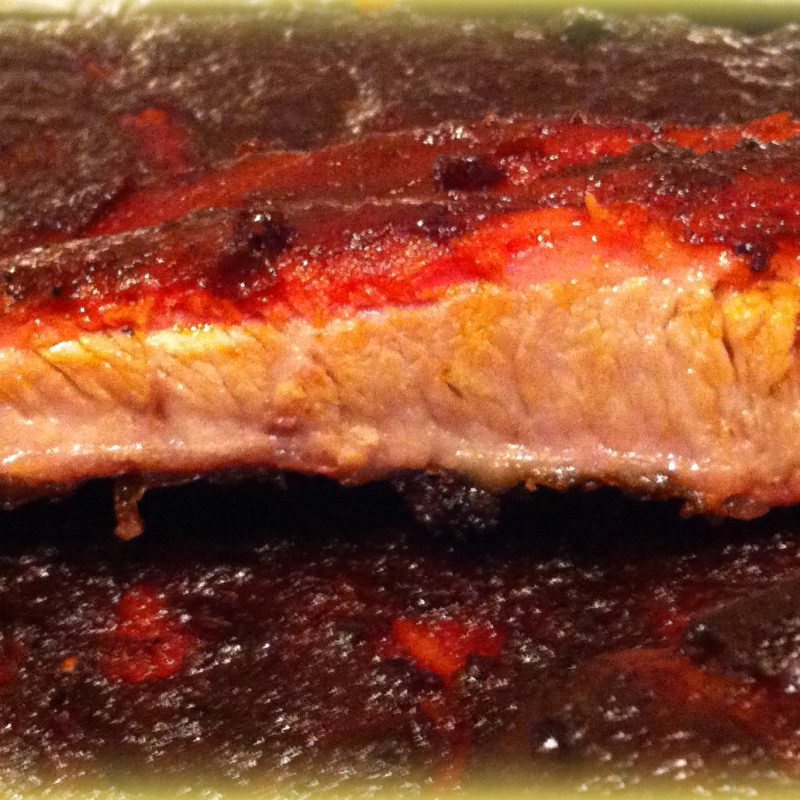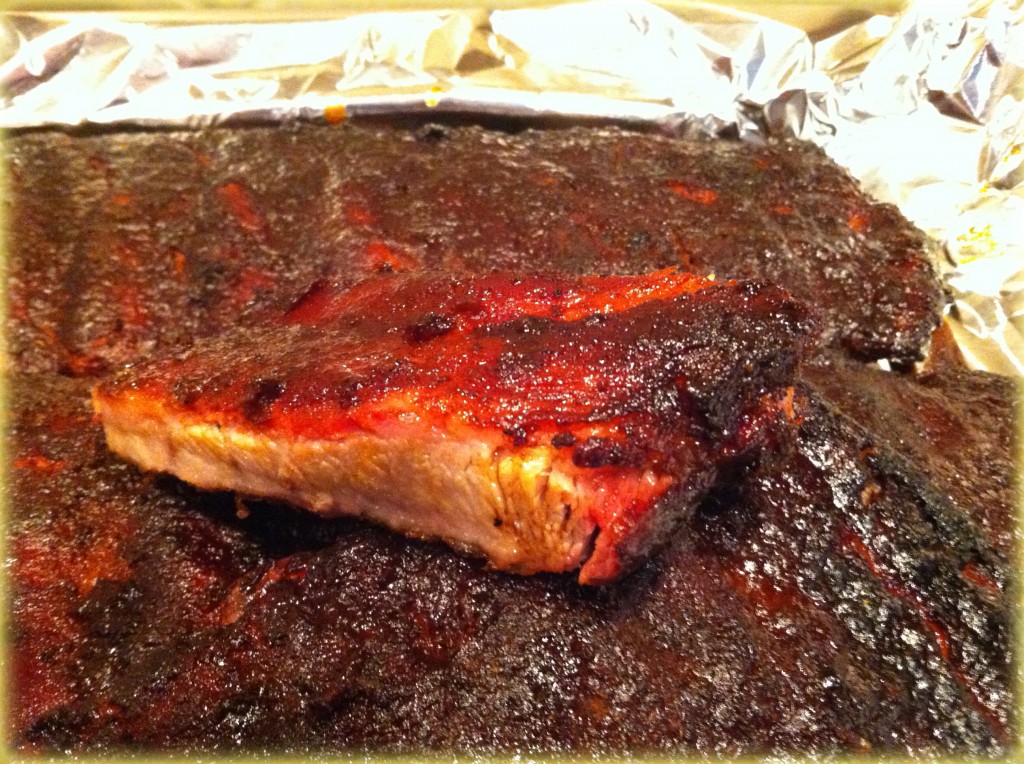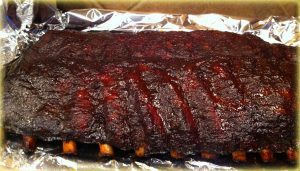When your friends and family ask, "What makes this taste so good?"...
You can proudly say, "It's My Rub!"
When your friends and family ask, "What makes this taste so good?"...
You can proudly say, "It's My Rub!"

Smoked Pork Ribs Recipe Summary:
In-Depth Smoked Pork Ribs Recipe:
I have probably smoked 30 to 40 racks of ribs over the past seven years, some on an offset smoker and on my XL BGE (Big Green Egg).
What I am looking for in ribs:
Growing up in Georgia, most barbecue places didn’t serve ribs, but a few did and it was a real treat to get good ribs. In 1991, I moved to Omaha, NE from Georgia and I missed barbecued pork so much that I felt deprived. However, I would get my barbecue fix when I would travel to Ames, Iowa on business periodically. There was a place there that served outstanding baby-back ribs that were smoked to perfection. This is where I began to really appreciate good ribs. I found good ribs in various places around the country, but I would often order ribs at restaurants and barbecue places to only be disappointed with the flavor and texture and wish that I could have some of those ribs from Ames.
I tried my hand at cooking ribs, but it was only about 7 years ago that I started truly investigating how to smoke ribs. I think that my technique produces really good tasting and near perfect texture in ribs now. I will share my technique below. Let me know what you think.
 So, what am I looking for in ribs? I want to taste a rib that has a dark mahogany bark that is not overly sauced, but is moist throughout. I want the meat to have a small pink smoke ring around the meat, but I want the taste to have a delicate smoky flavor. When you bite into the rib, the meat should have a slight tug, but the meat should come cleanly away from the bone. The taste should be slightly tangy with a hint of smoke, but the pork rib flavor should take the show. The meat should not be “falling off the bone”. If the meat is falling off the bone, it is way over cooked and has more than likely lost a lot of flavor. If ribs taste like they were cooked in an oven, they are over cooked or have been cooked in an oven.
So, what am I looking for in ribs? I want to taste a rib that has a dark mahogany bark that is not overly sauced, but is moist throughout. I want the meat to have a small pink smoke ring around the meat, but I want the taste to have a delicate smoky flavor. When you bite into the rib, the meat should have a slight tug, but the meat should come cleanly away from the bone. The taste should be slightly tangy with a hint of smoke, but the pork rib flavor should take the show. The meat should not be “falling off the bone”. If the meat is falling off the bone, it is way over cooked and has more than likely lost a lot of flavor. If ribs taste like they were cooked in an oven, they are over cooked or have been cooked in an oven.
There are several types of pork ribs that you can buy, but I greatly prefer spareribs over baby-back, but both are good. I buy St. Louis style spareribs. St. Louis style ribs have been trimmed up and have been cut to cook more evenly, but additional trimming still may be needed. I also look for marbling or ribs that have a higher fat within the meat itself. This fat will render out and will provide you with a moister and tastier product.
Baby-back ribs are also known as loin-back ribs and come from the back of the animal where the ribs meet the spine. Spareribs are from the front side and connect to the sternum. If you buy a full rack of spareribs, it will include the sternum and also flap meat from the trailing end of the ribs. The area where the ribs meat the sternum contains a lot of cartilage and is unpleasant to eat. St. Louis style ribs trim off the sternum area and the flap meat for a more pleasant looking and eating experience.
Trimming your Spareribs and Removing the Membrane
I usually rub the ribs with grape seed oil and then apply “It’s My Rub!” Smooth Blend, but Power Blend works well too if you want a more intense rub flavor in the meat. Cover the ribs generously with the rub on the meat and let it “dry brine” for at least 6 hours or overnight.
Another method that works well is to cover the ribs with mustard and then apply the rub. Try it both ways and let me know which you like better.
Loading the Big Green Egg with Lump
I prefer oak lump charcoal and really like “RockWood Lump Charcoal” , Ozark Oak Natural Lump or Royal Oak. Some lump just has a nasty flavor that it imparts into the meat. You want to choose a clean burning lump.
I typically load the lump up to the fire ring in the BGE. You will want to use the Plate Setter (convEggtor) after starting the coals.
Clean smoke refers to the smoke that comes off of the fire after the impurities have burned off and you get a nice and natural smell from the wood that you are using to create the smoke. When you first start a fire, you will get a lot of white/grey smoke that has an acrid smell. You want to wait until the acrid smell burns off before putting your spareribs on to cook. You can also get acrid smoke from fat dripping down on your coals to avoid this, use a raised drip pan.
Plate Setter (convEggtor), Drip Pan, Grid and Water Bowl
On the Big Green Egg, you use the Plate Setter (convEggtor) to turn the BGE into a smoker/convection oven. In addition, when cooking spareribs you will want to use a drip pan to catch the spareribs dripping. You need to elevate the drip pan off the plate setter to keep the drippings from creating acrid smoke. To do this, create three spacers by balling up aluminum foil into 1” balls. Place the aluminum balls on the plate setter followed by the drip pan on top of the aluminum balls. In other words, put the Plate Setter in the BGE and then place the aluminum balls on the plate setter in three places so as to support your drip pan. Then put the drip pan on top of the foil balls and then place your grate/grid in the BGE.
Place a small aluminum pan filled with water on the grate while cooking the spareribs. This will help keep you meat moist and promotes a better smoke ring in your meat.
Get your temperature regulated on the BGE before adding your meat.
Setting up a Metal Grill to Cook Using Indirect Heat
You can smoke spareribs on whatever device you have. If using a metal grill that does not have a heat deflector like the BGE’s Plate Setter, you will want to stack you coals on one side of the grill and cook the meat on the other side of the grill so that the meat is not above the coals. This is called indirect cooking. You will also want to align the lid so that the air vents are on the side of the meat to create a heat convection and to direct the smoke across the meat.
When loading my lump I use both hardwood chunks and hardwood chips. I prefer pecan or hickory chunks and place them evenly spaced about 6 inches from the middle of the fire ring on top of the lump. I then sprinkle apple wood chips over the surface of the coals. This provides constant smoke as the coals burn from the middle outwardly.
I have never found an advantage to soaking the chips or chunks ahead. The coals typically burn from the center outwardly and by the time the fire reaches the majority of the chips, they have long dried out anyway.
Starting your Cooker and Getting it to Temp
Starting a Big Green Egg for a low and slow cook is much different than offset smoker or metal grills. The BGE is very well insulated and maintains heat and temperature very well where as a metal cooker loses heat and temperature very fast. Therefore, when starting a BGE for low and slow, start light the coals in the middle and let the BGE come up to temperature slowly to a dome temperature of approximately 260 degree’s (grate temp about 250 degrees). I usually light my BGE about an hour before putting on the meat to get “clean smoke” and to stabilize the temp by adjusting the openings at the top and bottom of the BGE. If you start you BGE and the temp gets too high, it can be very difficult to get the temp back down and can waste a lot of time. Tend to your fire during this phase.
With metal cookers, you usually will get the fire hotter at first and place you meat on at a higher temperature, usually around 325 degrees because you will lose a lot of heat when putting your meat on the cooker.
Placing the Spareribs in the Smoker
Place the spareribs on the BGE in the middle of the grid over the drip pan. If you are using another type of smoker, place the meat where the smoke and air can flow evenly over the meat. Monitor the temp periodically over the next couple of hours to make sure that the temp is stable.
Mopping the Ribs
Mop the ribs with the mopping sauce every hour until you reach 165 degrees. Click HERE for the recipe to the mopping sauce.
Alternatively, fill a spray bottle with apple juice. Sprits the ribs with the apple juice every hour.
Wrapping vs Not Wrapping During the Cook
I prefer to wrap the meat in butcher paper about the 165 degree mark, but you don’t have to wrap the spareribs at all, especially on a BGE. Butcher paper absorbs the fat and lets it drip through while protecting the meat and keeping in the moisture. I prefer mopping or sprinkling more rub on the top of the ribs and then spritz then ribs again just before wrapping them.
Some folks prefer to wrap using aluminum foil and then add margarine, juice, brown sugar, etc. Though I have eaten some tasty ribs cooked in that method, I prefer not to use that method, because I think foil creates a steaming effect that renders out too much of the flavorful pork fat. It is the fat that holds the flavor and I think the margarine is replacing the good pork flavor with the flavor of margarine and brown sugar.
Wrapping will reduce the time that it takes to cook the ribs.
When cooking ribs and other meats, you may notice that the internal temperature of the meat will get to a certain temperature, around 165 degrees, and then will stall, not increasing sometimes for hours. I have actually seen the internal temperature get up to 170 degrees and then start to fall all the way down to 158 degrees without a change in the cooker’s temperature. This is called the stall phase and requires nothing from you except patience. That said, wrapping the meat when it reaches 165 degrees helps to prevent stalls.
What is happening? My understanding of this is limited, but I have read that it is caused when moisture evaporates from the surface and the evaporation effect itself causes the meat to cool just the same way that perspiration helps to cool you on a hot day. Found here: http://amazingribs.com/tips_and_technique/the_stall.html
Back to top
When are They Done?
I usually take spareribs off when the internal temperature is between 189 and 195 degrees. I wrap the meat with another couple of sheets of butcher paper and put them in a Styrofoam cooler for up to 5 hours. They can be eaten at this point, but prefer to take them to another level.
sheets of butcher paper and put them in a Styrofoam cooler for up to 5 hours. They can be eaten at this point, but prefer to take them to another level.
About 45 minutes before serving the ribs, create a mop sauce (recipe above). Preheat your grill to about 350 degrees. Take the ribs from Styrofoam cooler and place on grill. Using a sauce mop or brush, mop the sauce on the ribs. Remove from the grill when the sauce has “tightened up” and have a slight crispiness to the edges. This is a pretty fast process and takes about 5 to 8 minutes. The objective is to add the sauce for moisture and flavor and tighten the sauce up on the ribs. You are not attempting to cook the ribs. The ribs do not require additional resting, before serving them to your guests.
Overcooking
If your spareribs are “falling off the bone” they are over cooked. Also, every degree above 203 degrees is a loss in flavor. Flavor is in the fat and connective tissue. When the temperature goes too high, there is no way for the proteins to hold the flavor molecules and you might as well have cooked the spareribs in an oven because you will have lost all the smoke and flavors that you worked so hard to get into the meat.
If you stand ribs on their ends or turn the ribs over, you can more easily see the contour of the ribs. Take a sharp knife or an electric and follow the contours of the ribs to separate the ribs for serving.
Barbecue Dipping Sauce
Click HERE for the recipe to the barbecue sauce.
We hope this helps with your next or first smoked pork ribs! And, when people ask, “what makes the taste so good?”…you can proudly say, “It’s My Rub!”
Thanks for reading!
Bruce and Kelley Underwood
Copyright 2014 Underwood’s It’s My Food!, LLC
You must be logged in to post a comment.
907 Farm Path, Brenham, TX 77833| Email:
bruce.underwood@itsmyrub.com | Phone: 512-635-6052
Copyright 2021, Underwood's "It's My Food!", LLC. All Rights Reserved.
Good information! I am a BBQ man myself and I don’t eat commercial BBQ as I call it. And with the information on this site and pratice you to will be BBQ snob. My temps and techniques are a little different but it is personal preference and type of equipment used.